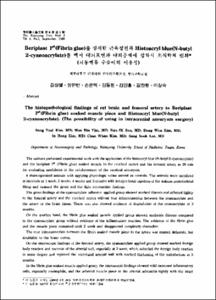Beriplast P(Fibrin glue)를 점적한 근육절편과 Histoacryl blue(N-butyl 2-cyanoacrylate)를 백서 대뇌표면과 대퇴동맥에 접착시 조직학적 변화 (뇌동맥류 수술에의 이용성)
- Keimyung Author(s)
- Kim, Sang Youl; Yim, Man Bin; Son, Eun Ik; Kim, Dong Won; Kim, In Hong; Lee, Sang Sook
- Journal Title
- Keimyung Medical Journal
- Issued Date
- 1989
- Volume
- 8
- Issue
- 1
- Abstract
- The authors performed experimental work with the application of the histoacryl blue(N-butyl 2-cyanoacrylate and the beriplast P® (Fibrin glue) soaked muscle to the cerebral cortex and the femoral artery in 26 rats for evaluating usefulness in the reinforcement of the cerebral aneurysm. 4 sham-operated animals with applying physiologic saline served as controls. The animals were sacrificed at intervals as 1 week, 2 weeks, 4weeks and 3 months with intraperitonal injection of the sodium pentobarbital 60mg and examed the gross and the light microscopic findings. The gross findings of the cyanoacrylate adhesive applied group showed marked fibrosis and adhered tightly to the femoral artery and the cerebral cortex without true interconnection between the cyanoacrylate and the artery or the brain tissue. There was also showed evidence of degradation of the cyanoacrylate at 3 months. On the another hand, the fibrin glue soaked muscle applied group showed moderate fibrosis compared to the cyanoacrylate group without evidence of the inflammatory reaction. The evidence of the fibrin glue and the muscle piece remained until 2 week and disappeared completely thereafter. The true interconnection between fibrin soaked muscle piece to the artery was existed definitely, but doubtable to the brain cortex. On the microscopic findings of the femoral artery, the cyanoacrylate applied group showed marked foreign body reaction and necrosis of the arterial wall, especially at 2 week, which subsided the foreign body reaction in some degree and repaired the necrotized arterial wall with marked thickening of the endothelium at 3 months. In the fibrin glue soaked muscle applied group, the microscopic findings showed mild increased inflammatory cells, especially eosinophile, and the adhered muscle piece to the arterial adventitia tightly with the intact arterial wall at 2 weeks.
The evidence of the fibrin glue disappeared and the muscle cells showed necrosis since 2 weeks. At 4 weeks, only small amount of the muscle cells remained with capillary proliferation at applying site and absence of the muscle cells with increased fibrosis with intact arterial wall at 3 months. On the brain specimen, the cyanoacrylate adhesive applied group showed marked thickening of the meningeal membrane with the increased inflamatory cells, especially at 2 weeks. The fibrin glue soaked muscle piece applied group showed only mild meningeal thickening with near absence of the inflammatory cells. The results of this experiment showed doutable tissue acceptance of the cyanoacylate(N-butyl 2-cyanoacry-late) in using for coating or wrapping of the aneurysm and the fibrin glue soaked muscle showed tissue acceptance, but the fate of the fibrin glue and the muscle piece disappeared 2 or 4 weeks later with fibrosis only. So the fibrin glue have to be used with another non-toxic, permanent material for the reinforcement of the cerebral aneurysm.
- Alternative Title
- The histopathological findings of rat brain and femoral artery to Beriplast
P®(Fibrin glue) soaked muscle piece and Histoacryl blue(N-butyl 2-cyanoacrylate). (The possibility of using in intracranial aneurysm surgery)
- Publisher
- Keimyung University School of Medicine
- Citation
- 김상열 et al. (1989). Beriplast P(Fibrin glue)를 점적한 근육절편과 Histoacryl blue(N-butyl 2-cyanoacrylate)를 백서 대뇌표면과 대퇴동맥에 접착시 조직학적 변화 (뇌동맥류 수술에의 이용성). Keimyung Medical Journal, 8(1), 122–133.
- Type
- Article
Items in Repository are protected by copyright, with all rights reserved, unless otherwise indicated.
